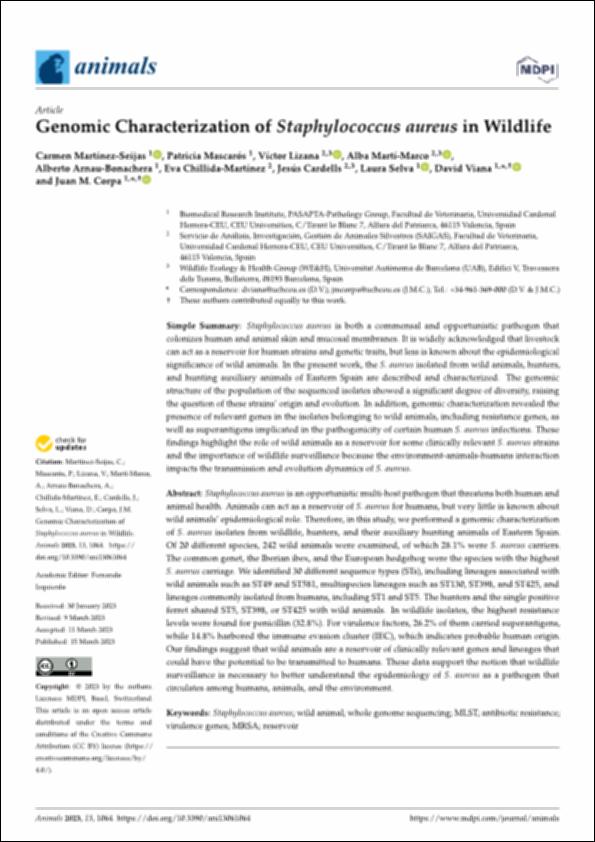Please use this identifier to cite or link to this item:
http://hdl.handle.net/10637/15147Genomic characterization of "Staphylococcus aureus" in wildlife
| Title: | Genomic characterization of "Staphylococcus aureus" in wildlife |
| Authors : | Martínez Seijas, Carmen Mascarós Núñez, Patricia Lizana Martín, Víctor Manuel Martí Marco, Alba Arnau Bonachera, Alberto Chillida Martínez, Eva Cardells Peris, Jesús Selva Martínez, Laura Viana Martín, David Corpa Arenas, Juan Manuel |
| Keywords: | Genética animal; Animal genetics; Animal salvaje; Wild animals; Estafilococos; Staphylococcus |
| Publisher: | MDPI |
| Citation: | Martínez-Seijas, C., Mascarós, P., Lizana, V., Martí-Marco, A., Arnau-Bonachera, A., Chillida-Martínez, E., Cardells, J., Selva, L., Viana, D. & Corpa, J.M. (2023). Genomic characterization of "Staphylococcus aureus" in wildlife. Animals, vol. 13, i. 6, art. 1064 (15 mar.). DOI: https://doi.org/10.3390/ani13061064 |
| Abstract: | Staphylococcus aureus is an opportunistic multi-host pathogen that threatens both human and animal health. Animals can act as a reservoir of S. aureus for humans, but very little is known about wild animals’ epidemiological role. Therefore, in this study, we performed a genomic characterization of S. aureus isolates from wildlife, hunters, and their auxiliary hunting animals of Eastern Spain. Of 20 different species, 242 wild animals were examined, of which 28.1% were S. aureus carriers. The common genet, the Iberian ibex, and the European hedgehog were the species with the highest S. aureus carriage. We identified 30 different sequence types (STs), including lineages associated with wild animals such as ST49 and ST581, multispecies lineages such as ST130, ST398, and ST425, and lineages commonly isolated from humans, including ST1 and ST5. The hunters and the single positive ferret shared ST5, ST398, or ST425 with wild animals. In wildlife isolates, the highest resistance levels were found for penicillin (32.8%). For virulence factors, 26.2% of them carried superantigens, while 14.8% harbored the immune evasion cluster (IEC), which indicates probable human origin. Our findings suggest that wild animals are a reservoir of clinically relevant genes and lineages that could have the potential to be transmitted to humans. These data support the notion that wildlife surveillance is necessary to better understand the epidemiology of S. aureus as a pathogen that circulates among humans, animals, and the environment. |
| URI: | http://hdl.handle.net/10637/15147 |
| Rights : | Open Access http://creativecommons.org/licenses/by/4.0/deed.es |
| ISSN: | 2076-2615 (Electrónico) |
| Issue Date: | 15-Mar-2023 |
| Center : | Universidad Cardenal Herrera-CEU |
| Appears in Collections: | Dpto. Producción y Sanidad Animal, Salud Pública Veterinaria y Ciencia y Tecnología de los Alimentos |
Items in DSpace are protected by copyright, with all rights reserved, unless otherwise indicated.


